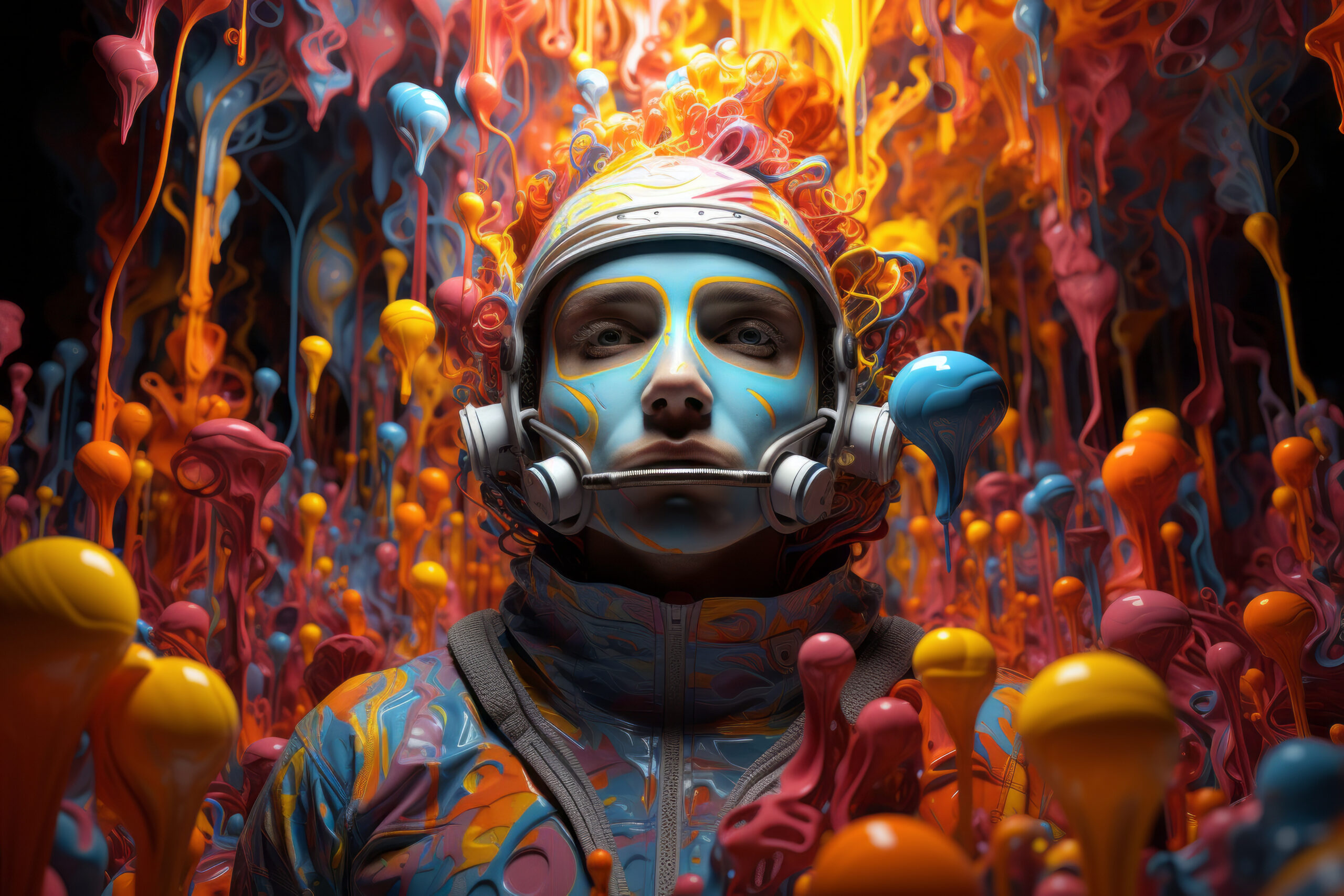“I want to express my feelings rather than illustrate them.” – Jackson Pollock
Chaos, Clicks, and Celebrity Paint-Splatter
Perfection is overrated
If Pollock were alive in 2024, he’d probably be trending on TikTok under #DripTok, half the internet debating whether his splatters were art or just messy DIY projects gone rogue. But here’s the thing: Pollock still matters. His work wasn’t just about paint it was about permission. Permission to make a mess, to experiment, to rip art out of frames and fling it on the floor.
And in a year where chaos rules AI art floods timelines, digital galleries host infinite exhibitions, and even pop stars like Ed Sheeran are drip-painting Pollock’s legacy doesn’t sit in a museum corner. It’s right here, splashing across the present.
Pollock’s Big Idea
Mess as Method
Pollock wasn’t selling pretty pictures. He was selling process. The drip, the pour, the fling action painting was his way of saying that art is alive in the making, not just the finished product. His canvases weren’t passive; they were arenas.
In 2024, this resonates harder than ever. We live in a constant splatter of information scrolls, streams, pings, swipes. Pollock’s chaos mirrors our chaos. Except instead of feeling crushed by it, his work tells us: own it, shape it, turn the noise into something raw and human.
Pollock and the Algorithm
Would TikTok have shadowbanned him?
The guy who once laid a canvas on the floor to throw enamel at it would probably thrive in today’s algorithmic attention economy. Think about it: viral process videos, livestream drip sessions, collabs with fashion brands. His work already had that cinematic quality big, dramatic, unpredictable.
But here’s the irony: while we try to decode the algorithm, Pollock was reminding us that unpredictability is the point. The splatter, the accident, the unplanned drop that’s the moment of truth.
When Celebrities Pick Up the Brush
Ed Sheeran enters the chat
Yes, Ed Sheeran paints. And in 2020, when he started showing his work, critics quickly compared it to Pollock’s drip style. Headlines called it “Pollock-esque,” and collectors lined up. Some rolled their eyes, others loved it.
What does this tell us? That Pollock’s visual language random, raw, chaotic has become shorthand for authenticity. In a world where celebrity brands are polished within an inch of their lives, splatter painting screams, “I didn’t overthink this.” It’s both rebellious and oddly comforting.
Sheeran may not be reinventing Abstract Expressionism, but he’s proof that Pollock’s shadow stretches far beyond the art world.
Pollock and the Cold War Aesthetic
From propaganda to free speech.
Back in the 1950s, Pollock’s art was packaged as proof of freedom. While socialist realism plastered walls with political heroes, America flaunted Pollock’s chaos as a cultural flex. His drip paintings said: here, we let people be messy, weird, uncontainable.
Fast-forward: in 2024, freedom looks different. It’s not about the Cold War anymore it’s about the fight for digital autonomy. Who owns your data? Who owns your AI-generated art? Pollock’s canvases remind us that chaos isn’t just spectacle it’s also resistance.
Style Notes: The Drip Still Hits
Copy the vibe, not the paint.
Pollock’s actual drip method has been imitated endlessly. From dorm-room posters to AI filters that promise “Pollock-ify your selfies,” his visual vocabulary has gone mainstream.
But the real trick isn’t the technique it’s the attitude. He painted on the floor so he could move around the canvas, see it from all sides. He swapped brushes for sticks, knives, even turkey basters. It wasn’t about tools it was about breaking habits.
That’s why he still feels fresh in 2024. The medium may change oil, pixels, NFTs, or VR but the hunger for new methods never does.
The Meme-ification of Pollock
“My kid could do that” goes viral.
Every Pollock conversation eventually circles back to the same complaint: “It looks like a kid did it.” Today, that’s a meme. Tweets comparing toddler finger paintings to Pollock’s canvases rack up likes by the thousands.
But here’s the twist: that critique was always the point. Pollock stripped art of pretense. He showed that process, spontaneity, and accident have value. In 2024, when AI generates “perfect” paintings in seconds, Pollock’s mess feels radical again. Imperfection sells.
What’s Pollock Worth in 2024?
Spoiler: a lot.
Pollock’s paintings remain some of the most expensive in history. No. 5, 1948 sold for $140 million in 2006. Number 17A went for $200 million in 2016. Prices like that are why you don’t see his works casually pop up on eBay.
But here’s the kicker: in 2024, it’s not just billionaires who keep him alive. His influence trickles down through sneakers with splatter prints, Instagram reels that mimic his style, and yes, Ed Sheeran’s art. Pollock lives equally in Christie’s auction rooms and TikTok feeds.
Best Reads: The Essentials
Smart books, sharp takes.
- Elizabeth Currid-Halkett – The Warhol Economy: “Spectacle is strategy, culture is capital.”
- Harold Rosenberg – The American Action Painters: “The canvas is an arena, not a window.”
- Hito Steyerl – Duty Free Art: “Art after the upload, politics included.”
- James Gleick – Chaos: Making a New Science: “Order hides inside disorder if you know where to look.”
- Legacy Russell – Glitch Feminism: “Error as agency in a high-noise world.”
- Pepe Karmel – Jackson Pollock: Interviews, Articles, and Reviews: “Pollock in his words, plus the best and worst hot takes.”
Thoughts
Mess as method.
Pollock works in 2024 because the world already looks like his canvas. Algorithms drip content, culture runs on spectacle, and perfection feels fake. His real lesson isn’t how to splatter it’s how to risk.
The splatter can be copied. The process videos can be faked. But the human misstep the accident, the chaos, the refusal to control every outcome that’s the art. And in 2024, that’s exactly what we need.
References
- Life Magazine (1949):“Is He the Greatest Living Painter in the United States?”
- MoMA (2024):Jackson Pollock Collection
- Tate Modern (2024): Abstract Expressionism Archive




